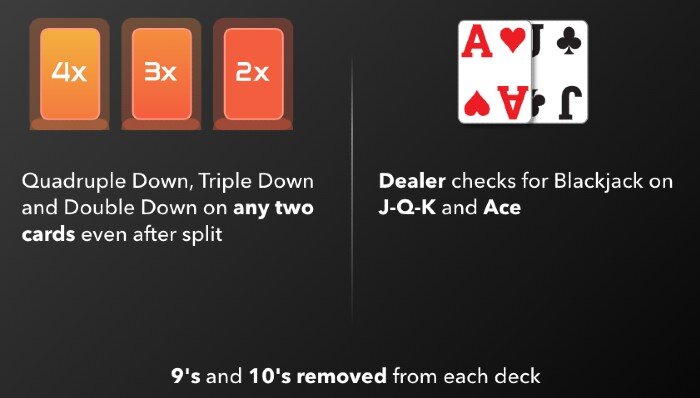Quick Blackjack Tutorial
Posted : admin On 4/10/2022Hawaiian Cookie. A Designer's Desk. Here's a quick tutorial! /blackjack - blackjack.play /blackjack - See their wins, losses, w/l ratio /blackjackadmin - See admin stats To-Do List 1. Add sessions so players can continuously play games (Done) 2. Make EXP a form of currency able to be used. 1.5x blackjack multiplier (Done) 4. All messages configurable 5. Use these Blackjack Strategy Charts to learn the correct decision for every hand. Basic Strategy is the first step to beating blackjack with card counting. Blackjack is a card game that, along with Roulette and Slots, is one of the most popular games in casinos, both online and offline. The game is played against a Dealer with the aim of getting a higher score than them and as close to 21 as possible without ‘Busting’ – going over.
Introduction
Blackjack is the game of choice for many players who are serious about gambling. Unlike slots, this is a skill-based game: you need to know all the rules and also be thorough with strategy to chalk up wins regularly; mere luck just won’t do.

There are a lot of players who play blackjack with real money, but for fun and as a hobby, the casual gamblers. They usually play with minimal bets and are happy to win every now and then. There are also players who are serious about the game and in fact make a living out of it; these are the professional blackjack players. On this page we will take a quick look at how to become a professional blackjack player.
Contents
Becoming a Professional Blackjack Player: 5 Rules to Follow
Most of the stuff about blackjack strategy that you read online or hear about has to do with basic blackjack strategy; they are there in keeping with the ‘educating the masses’ methodology. They will not be of much use to you if you are looking to become a professional player. Here are 5 rules you can follow to become a professional blackjack player.
Know when to use the Doctor Pepper Rule. Another rule that players follow in blackjack is the Doctor Pepper rule: hit a hand of 12 consisting of 10 and 2 if the dealer’s face card is 4; stand for any other hand of 12 for the same dealer’s face card. Generically, this rule may work. However, when you break it down further, you will find that there are 4 permutations to forming a 12-hand: 7 and 5, 8 and 4, 9 and 3, and 10 and 2.
If your hand has a 10 and a 2, the probability of landing another 10 if you hit goes down slightly, and your chances of winning go up to 40%. However, for any of the other hands, say a hand of 7 and 5, the probability of landing a 10-value card increases, and your odds of winning while hitting therefore goes down a notch to 39.75%. In such a scenario, hitting may not actually work to your advantage at times.
Read the game carefully. You will have to dig deeper to understand the game; for instance, you will find that compared to what you get in a standard chart, there could a difference in approach to playing depending on the value of the cards in a hand. So if conventional blackjack wisdom is to hit instead of standing if you have a hand of 16 when the dealer’s first card is an Ace, that situation could very well vary depending on how many cards in your hand make up the 16 and what the dealer’s face card is.
Assume you have a hand of 16 – a 6 and a 10, while the dealer has a Jack as the face card. If you apply the law of probability here, the odds of winning remain almost the same regardless of whether you hit or stand – 23% for standing against 23.5% for hitting. This is because the 2 big cards that could contribute to a bust – the 10 and the Jack, along with the medium-size card that is 6, are already dealt and hence out of the deck; bringing down the possibility of busting.
Use the Rule of 45 wisely. Many times the way you play will actually vary also depending on the number of cards that make up your hand. To understand this better, let us again take the example of a hand of 16, with the dealer’s face card being a Jack. Conventional wisdom dictates that you hit. However, if your hand has 3 or more cards, the better option could even possibly be to stand because the odds of going bust go higher as the number of cards in your hand increases. In such a situation, the Rule of 45 may actually backfire, as it is meant to be used only when the dealer’s face card is a 10.
Ensure your bankroll matches your ambition. Blackjack is a game of skill and even as a professional who plays the game for a living you cannot expect to win all the time. Ensure that you have a bankroll that is able to help you tide over the times you lose. You cannot expect to win a 6-figure pay packet with a bankroll of $100 all the time, for instance; a big bankroll helps.
A good bankroll would be at least $40,000, for instance. Because assuming that the average bet in a regular game is about $4 to $5, you would need to bet way higher to be able to make a living out of blackjack, at least 300 times higher. Playing higher wagers also gets you juicy comps at the casinos you visit.
Card counting is an option. While blackjack strategy is one way to go about ensuring you win more often and lose lesser, another way, a little controversial one at that, is by counting cards. Card counting works well in land-based casinos: you keep track of the cards that have already been dealt and know the ones that are still to come; this helps you tweak your betting according to your analysis. It is not illegal, but casinos definitely do not encourage it because it allows the player a shot at lowering the house edge.
At the end of it all, it is about practice. You do not become a professional blackjack player overnight. The only way you take that leap forward is by constantly practicing. Play initially with family and friends, and then with small money. Then head into moderate and later big money play. A good way to practice is to sign up at one of the online casinos that offer blackjack and play in the free-play mode.
Blackjack Success Stories
There are a number of fantastic success stories you read about when you look at professional blackjack players. One of the most iconic is the story of Don Johnson. Johnson was the founder of Heritage Development, a company that offered software-driven wagering programs related to horse racing, but he is globally known as the man who took the Las Vegas casinos for a whopping $15 million in the space of 6 months in 2011.
After negotiating with the casinos for healthy discounts, he struck a gold vein during the period mentioned and won close to $6 million at the Tropicana, almost $5 million at the Borgata, and over $4 million at Caesar’s.
Another great story is that of Josh Axelrad. He is a professional card counter who is now on to other things. Back in the 1990s and early 2000s, he was part of a blackjack team that played in Vegas and won hundreds of thousands of dollars doing so. His experiences as a blackjack player in Vegas took the form of a memoir that was quite well received: Repeat Until Rich: A Professional Card Counter’s Chronicle of the Blackjack Wars, published by Penguin in 2010.
Recommended Books for Advanced Blackjack Players
There are a number of books that advanced blackjack players can read. These are books by former blackjack experts and players and have, apart from information on technique and skill, a wealth of knowledge that you might not otherwise find. One back that you would find an interesting read is Playing Blackjack as a Business, written by Lawrence Revere, a professional blackjack player who was also a pit boss.
Armed with a math degree from the University of Nebraska, he wrote Playing Blackjack as a Business and was also responsible for putting together a series of card counting strategies, including the Revere Point Count, the Revere Five Count Strategy, the Revere Plus-Minus Strategy, and the Ten Count Strategy.

Quick Poker Tutorial
Introduction
Every now and then I like to give myself a fun little programming challenge. I'll randomly pick some enjoyable task, like programming a game or blogging engine or what not, and impose a time limit, anywhere from an hour to an afternoon. Such little challenges keep the fun in programming and help me mentally recharge. After spending a week of programming boring data entry forms, such toy projects help remind me why I enjoy computer science and programming!
Anyway, a few months ago I decided to see if I couldn't create a simple online Blackjack game that would allow a single person to come to the site, enter their name and starting bankroll, and play Blackjack against a dealer. Blackjack is a popular casino game where players are playing against the House, which has a pre-defined set of rules. See the Blackjack Wikipedia entry for rules and basic strategy.

I was able to complete the task during an afternoon and thought I'd share it here for a more fun article during this holiday season. The application is created as an ASP.NET 2.0 web application and the complete code can be downloaded from the end of this article. Do keep in mind it was written in about three hours, so there may be some rough edges, but it does allow you to 'create' multiple players, allows for doubling down, and so on. Read on to learn more about the code and technology used to create this game.
Blackjack in a Nutshell
Blackjack is a card game where one or more players sit down at the table, facing off against the House (the dealer). The dealer deals from a dealing shoe that may hold multiple decks of cards to reduce the effect of card counting. Each player starts by making a wager. Then, all players (including the dealer) are delt two cards, with one of the dealer's cards delt face up and the other face down. The objective is to construct a hand that is closer to 21 'points' than the dealer's, where face cards are worth 10 points, non-face cards worth their natural value, and the Ace being able to be worth either 11 or 1 (it assumes the value that is most beneficial to the hand it is part of). A player 'busts' if their score exceeds 21 and they lose the hand.

After all players have completed their turn, the dealer reveals his face down card and must continually hit until his score is greater than or equal to 17 or he busts. If the dealer busts, all remaining players (those who did not bust) win. If the dealer did not bust, all players who had a lower score lose; those with an equivalent score 'push', meaning they neither win nor lose their wager.
That's the concept behind blackjack. There are some edge cases not discussed here, such as splitting and doubling down and buying insurance, but these are the core rules.
Quick Roulette Tutorial How To Play
Examining the Game's Workflow
The online blackjack game's workflow can be divided into two sections. First there's the initialization logic. After that, there is a workflow for playing a hand, and this workflow loops until a player reaches $0.00, at which point the system throws an Exception. I'm afraid I didn't have time to address this, so I'll leave this as a challenge for the reader! (Ideally, it should remove the user(s) who hit $0.00, or maybe let them go talk to the burly guy in the corner about a short-term loan. But as it stands, the system blows up if any user reaches $0.00 or less... so there's one incentive to bet conservatively.)
The initialization workflow starts by allowing the user to choose how many decks of cards will be in the dealing shoe. Next, the user is asked to specify the names and starting bankrolls of those players who will be sitting at the table. Each player is modeled by a User object, which is defined by the User.cs class in the App_Code folder. There's also a Game class that models the game and a GameEngine class that has methods that operates against the current Game instance that is stored in session state.
The GameEngine class has static methods for performing high-level, game-related operations: creating a new game, managing the Game object in session state, dealing, adding a player to the game, and getting a list of current players. This GameEngine class is used by an ObjectDataSource on the PickUsers.aspx page to add new users to the game through a DetailsView and to list the current players in a GridView, as the screenshot below shows.
Once the game's players have been entered, the in-game workflow begins. Each user is shown their current bankroll and asked how much they want to wager. A RangeValidator is used to ensure that the user's bet does not exceed their bankroll.
Next, list of users and their cards are displayed and each user can decide whether they want to hit or stay. (I also implemented doubling down, which is a blackjack variant where you double your bet but get only one card dealt and then your turn ends.) The dealer's one face up card is also shown. After each player makes his moves, the dealer reveals her hand and follows the rules prescribed to the House. The workflow then ends by adjusting the player's bankrolls based on the end results. In the screenshot below, Scott and Jisun busted because they exceeded 21 points. Sam reached 21, while Dave stayed on 19. The dealer ended up with 20, meaning Sam was the only winner!
Clicking the Play Again restarts the in-game workflow, returning to the page where they players may make their bets.
| Suggestions for Improvement |
|---|
Avid 4Guys reader Tim L. wrote in to share the following suggestion for improving the application: The most universal way to represent cards in text form is [to] represent numbers 2 through 9 with that digit, represent 10 as 'T', and Jack through Ace with the first letter (always [uppercase]). Suit can then be expressed as 'c', 'd', 'h' or 's' (always lowercase).Thanks for the suggestion, Tim! |
The Benefits of this Toy Application
If you decide to download and poke through this application, please do bear in mind that it was purposefully rushed, as I was racing against the clock to complete the project. Consequently, the code may be rather tattered in places, there are likely many spots where it should be refactored, and there are next to no comments. Regardless, I think that this application's code does offer some benefits for those brave enough to plow through it:
- It illustrates using the ObjectDataSource to interface with custom classes - all ASP.NET pages except for the trivial
Default.aspxuse ObjectDataSource controls to interface with the classes in theApp_Codefolder. In all but the game-playing page (PlayHand.aspx), there's virtually no code in the page as it's all handled by the ObjectDataSource and data Web controls in the page. - It's a working (fun!) game - Next time you're in that meeting with your laptop, but no Internet connection, open this project in Visual Studio and start playing! If your boss catches you or asks what in tarnation you are doing, you can explain you are multi-tasking - attending the meeting and improving your ASP.NET development skills
Happy Programming!
By Scott MitchellFurther Reading:

Attachments
(in ZIP format)